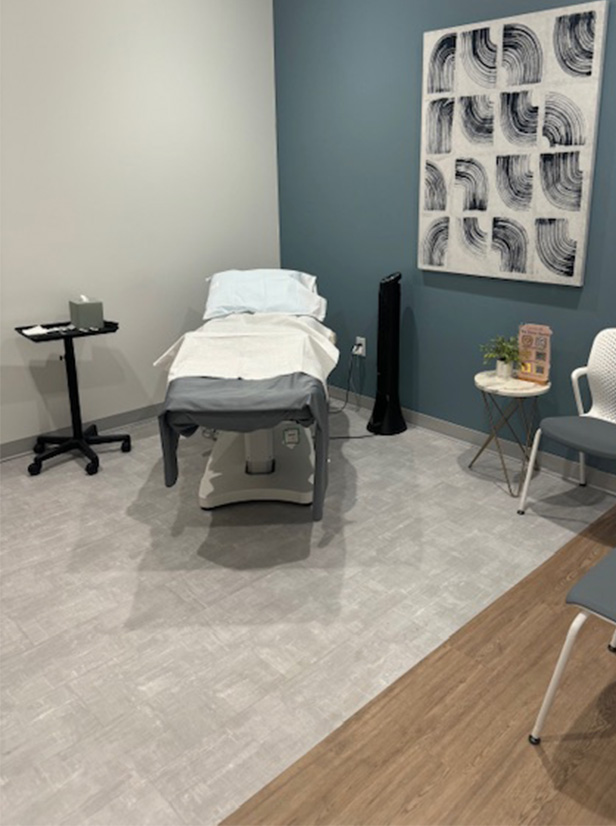Neural therapy is an emerging treatment modality in the functional medicine world, designed to target disturbances in the autonomic nervous system and facilitate natural healing. By using localized injections, practitioners aim to “reset” areas where nerve dysfunction occurs, providing relief from chronic pain and even emotional trauma, like PTSD. New research supports the effectiveness of neural therapy in treating conditions like PTSD and chronic pain, highlighting its potential as a valuable treatment option.
In this blog, we’ll explore the therapeutic benefits of neural therapy, how it works, and why it’s becoming a go-to for functional medicine practitioners looking to offer holistic, root-cause solutions. We’ll also dive into specific injection techniques like Stellate ganglion, pelvic, and celiac injections, and how these methods help alleviate both physical and emotional stress by shutting down the body’s fight-or-flight mode.
What is Neural Therapy?
Neural therapy uses targeted injections of local anesthetics, typically procaine or lidocaine, to reset areas of dysfunction in the autonomic nervous system. These dysfunctions, or “interference fields,” often arise from old injuries, scars, infections, or emotional trauma that create lingering disturbances in nerve signaling.
Procaine is metabolized by the enzyme pseudocholinesterase, which breaks it down into para-aminobenzoic acid (PABA).
When injected, the local anesthetic blocks the faulty nerve signaling and allows the body’s healing systems to restore balance. These injections are often placed in key areas such as scars, nerve pathways, or ganglia, depending on the patient’s symptoms.
How Does Neural Therapy Work?
At its core, neural therapy is about resetting the autonomic nervous system, which controls functions like digestion, heart rate, and stress responses. Over time, trauma, injuries, or chronic conditions can throw this system off balance, creating a cycle of dysfunction that leads to pain, inflammation, and systemic health issues.
Neural therapy can influence the central nervous system by modulating neuronal activity, which can help alleviate symptoms but also carries potential side effects. Application of procaine, for instance, can lead to depression of neuronal activity, causing hypersensitivity in the central nervous system, which might result in serious symptoms such as restlessness, shaking, and even respiratory failure.
Through a series of injections targeting specific interference fields, neural therapy helps “rewire” the body’s nerve signals. This allows the autonomic nervous system to move out of the fight-or-flight response and return to a state of balance, where healing can occur.
The injections don’t just mask pain; they help retrain the body to respond appropriately to stimuli, reducing inflammation, pain, and stress. When used in conjunction with other functional medicine protocols, neural therapy can accelerate healing by addressing deep-rooted causes of dysfunction.
Neural Therapy and Post Traumatic Stress Disorder: Rewiring Emotional Trauma
One of the most exciting applications of neural therapy is its use in treating PTSD (Post-Traumatic Stress Disorder) and other emotional traumas. PTSD is a condition that keeps the body locked in a constant state of fight-or-flight, as the nervous system struggles to process the traumatic event.
Neural therapy, especially through Stellate ganglion blocks, has shown promise in breaking this cycle. The Stellate ganglion is a group of nerves located in the neck that plays a significant role in the body’s sympathetic (fight-or-flight) response. By injecting a local anesthetic into this region, practitioners can “turn off” this heightened response, allowing the body to shift into a parasympathetic (rest-and-digest) state.
For individuals dealing with PTSD, this can result in immediate relief from anxiety, hypervigilance, and emotional distress. Many patients report feeling calmer, more grounded, and less reactive to stress after Stellate ganglion injections. These results can last for weeks or months, providing a powerful tool in PTSD management when combined with other therapies like counseling, EMDR, or mindfulness.
The Fight-or-Flight Shutdown: Relieving Pain and Stress
In addition to addressing PTSD, neural therapy is highly effective at shutting down the body’s chronic fight-or-flight mode, especially when used to relieve pain. Pain itself can trigger a stress response in the body, keeping individuals in a state of hyperarousal and preventing healing. By addressing the root cause of the pain—whether it’s an old scar, injury, or interference field—neural therapy breaks this cycle. Neural therapy works by blocking nerve conduction in peripheral nerves, thereby reducing pain and stress responses.
Stellate Injections: These injections target the Stellate ganglion in the neck and are often used for both emotional and physical stress relief. They can help with conditions ranging from PTSD and anxiety to chronic pain syndromes and migraines.
Pelvic and Celiac Injections: The pelvic and celiac ganglia are nerve clusters that also play crucial roles in the autonomic nervous system. Pelvic injections are often used to address lower body and pelvic pain, including conditions like endometriosis or pelvic floor dysfunction. Celiac injections target abdominal pain, digestive disorders, or even visceral issues like IBS. These injections work similarly to Stellate blocks, offering a way to shut down overactive nerve signaling in these areas.
Together, these injections help create a “systemic reset,” shutting down the body’s pain signals and stress responses and allowing the patient to move out of survival mode. For many, this leads to long-lasting relief from chronic pain, anxiety, and stress.
Why Neural Therapy Injections with Local Anesthetics?
Injections are the method of choice in neural therapy because they allow precise targeting of the interference fields causing dysfunction. The localized nature of the injections means that the anesthetic goes directly to the problem area, creating an immediate and focused effect. Procaine, an ester-type local anesthetic used in these injections, is hydrolyzed by plasma esterases into para-aminobenzoic acid (PABA), which is then excreted by the kidneys.
Topical treatments or oral medications don’t offer this same level of specificity and can take much longer to produce results. Neural therapy injections are also minimally invasive and involve little downtime, making them an attractive option for individuals seeking quick relief from complex conditions.
Benefits of Neural Therapy
1. Comprehensive Healing
Neural therapy works on both the physical and emotional levels, offering relief from chronic pain while addressing trauma and stress disorders like PTSD. The reset it provides allows patients to heal more holistically.
2. Non-Invasive
While injections are involved, the procedure is far less invasive than surgery and doesn’t require a lengthy recovery period. Most patients resume their normal activities shortly after treatment.
3. Pain and Stress Reduction
By targeting the autonomic nervous system, neural therapy helps patients transition out of the fight-or-flight response, offering long-term relief from both physical pain and emotional stress.
4. Personalized Treatment
Neural therapy is highly individualized, with each injection targeted at a specific area of dysfunction. This allows practitioners to craft treatment plans tailored to the patient’s unique needs.
5. Enhances Other Functional Medicine Protocols
When used alongside hormone optimization, gut health protocols, or detox therapies, neural therapy can enhance outcomes by addressing nerve dysfunction that might be holding back progress in other areas of healing.
Conditions Treated with Neural Therapy
In addition to PTSD, chronic pain, and emotional stress, neural therapy has been used to successfully treat conditions like:
– Fibromyalgia
– Migraines and tension headaches
– Digestive disorders like IBS and Crohn’s disease
– Pelvic pain and endometriosis
– Autoimmune conditions such as Hashimoto’s or lupus
– Chronic fatigue and adrenal dysfunction
For patients dealing with hard-to-treat or multi-system issues, neural therapy offers a new avenue for relief.
Hear from our Patients: Testimonials
Patient One: Received Three Rounds of Stellate Injections
What is the main reason you decided to try Neural Therapy injections?
“The main reason was to calm the nervous system after struggling to do so independently, I would be considered to lead a “high stress” life as a business owner and have gone through several life challenges. It was also suggested by my provider.”
How would you describe the procedure?
“The procedure was easy, painless, calming/relaxing, and immediately helped me feel at peace. the side of your neck/head will feel numb for about 30 min to an hour after the procedure, but again, it’s painless and very comfortable.”
What benefits did you notice after your procedure?
“The biggest benefit after the procedure was, I felt more neutral across the board. Calmer, clear-headed, and more confident “everything would be ok”. Work/life events that would have increased stress didn’t feel as stressful.”
Any other feedback?
“The effects seem to have lasted 2-3 months at this time, but potentially could last longer.”
Patient Two: Received one Stellate paired with three Procaine IV’s
What is the main reason you decided to try Neural Therapy injections?
“Mainly for seasonal depression which has been pretty bad the past two years.”
How would you describe the procedure?
“It was painless and just the usual feeling of putting in an IV. The experience of the wooziness is tolerable for me because I do have a few glasses of wine occasionally and it just reminds me of that feeling. At the end of the procedure, I needed about 5 minutes for my brain to adjust and be able to walk.”
What benefits did you notice after your procedure?
“By the end of the second round I could notice a change in my ability to handle daily feelings. I wasn’t feeling the bouts of sadness. I was also taking a new antidepressant, and I believe this gave that boost my medication needed.”
Any other feedback?
“I will definitely be making this a regular course of treatment during the winter months of January and February in the coming year.”
Patient Three: Received 3 Rounds of Pelvic Neural Injections
What is the main reason you decided to try Neural Therapy?
I deal with menstrual cramps as well as some PTSD from past experiences, my provider told me this might be beneficial for me.
How would you describe the procedure?
It was painless for me; the injections are quick, and you are placed in a calming and relaxing room. After the injections I felt a calm wash over me and felt relaxed. This lasted throughout the next few days.
What benefits did you notice after your procedure?
After my second injection I did notice less menstrual cramping, an added benefit was a calmness that lasted multiple days and continued after my last injection. An added benefit was better sex after the procedure perhaps addressing some pelvic floor issues I had after having my first child. I like that there was no down time and experienced minimal bruising and no pain where the injections were placed.
Any other Feedback?
I am happy to make this part of my routine, the benefits are great and to feel calm and relaxed and healed is such a great feeling that I don’t often experience.
Conclusion
Neural therapy is a powerful tool in functional medicine, offering relief from both physical and emotional trauma through targeted injections. Whether you’re dealing with chronic pain, PTSD, or stress-related conditions, this minimally invasive technique can provide lasting benefits by resetting the autonomic nervous system. When combined with other holistic treatments like hormone optimization, gut healing, or detoxification protocols, neural therapy can accelerate recovery and unlock deeper levels of healing.
If you think neural therapy could be the key to addressing your chronic pain or trauma, consult with a functional medicine practitioner experienced in this technique. The combination of Stellate, pelvic, and celiac injections might just be the breakthrough you’ve been looking for.
Clinical Trials and Research
Evidence-Based Support for Neural Therapy
Neural therapy, a form of treatment that involves the use of local anesthetics such as procaine, has been gaining attention in recent years for its potential in treating various conditions, including post-traumatic stress disorder (PTSD) and depression. While more research is needed to fully understand the effects of neural therapy, existing studies suggest that it may be a valuable addition to traditional treatment approaches.
One clinical trial published in the Journal of Clinical Psychology found that neural therapy significantly reduced symptoms of PTSD in patients who had not responded to other treatments. Another study published in the Journal of Affective Disorders found that neural therapy was effective in reducing symptoms of depression in patients with treatment-resistant depression.
These findings are promising, and further research is needed to fully understand the potential benefits and risks of neural therapy. However, the existing evidence suggests that neural therapy may be a valuable tool in the treatment of various conditions, and it is an area of ongoing research and innovation.
Risks and Side Effects
Risks and Side Effects of Neural Therapy
Like any medical treatment, neural therapy has potential risks and side effects. It’s essential to be aware of these before undergoing treatment. Some of the main risks include:
- Allergic Reactions: Some individuals may have allergic reactions to local anesthetics like procaine, which can range from mild to severe.
- Nerve Damage: Though rare, improper administration of injections could result in nerve damage, particularly if pre-existing nerve conditions exist.
- Hypersensitivity Reactions: In rare cases, the central nervous system may exhibit hypersensitivity, leading to symptoms such as restlessness, shaking, or, in extreme cases, respiratory failure.
Understanding the Potential Downsides
While neural therapy has shown promise in treating various conditions, it is not without risks and side effects. As with any medical treatment, it is essential to understand the potential downsides of neural therapy before undergoing treatment.
One of the primary risks associated with neural therapy is the potential for allergic reactions to the local anesthetic used. Procaine, for example, can cause allergic reactions in some individuals, which can range from mild to severe. It is essential to discuss any allergies or sensitivities with your healthcare provider before undergoing neural therapy.
Another potential risk associated with neural therapy is the possibility of nerve damage. While rare, nerve damage can occur if the local anesthetic is not administered correctly or if the patient has a pre-existing condition that affects the nerves.
Additionally, neural therapy may not be suitable for everyone, particularly those with certain medical conditions or taking certain medications. It is essential to discuss your medical history and any medications you are taking with your healthcare provider before undergoing neural therapy.
Combining Neural Therapy with Other Therapies
Enhancing Treatment Outcomes through Integration
Neural therapy can be used in conjunction with other therapies to enhance treatment outcomes. For example, combining neural therapy with functional medicine approaches, such as nutritional therapy and lifestyle modifications, may be beneficial in treating conditions such as PTSD and depression.
One study published in the Journal of Clinical Psychology found that combining neural therapy with cognitive-behavioral therapy (CBT) resulted in improved treatment outcomes for patients with PTSD. Another study published in the Journal of Affective Disorders found that combining neural therapy with medication resulted in improved treatment outcomes for patients with treatment-resistant depression.
The key to successful integration is to work with a healthcare provider who is experienced in neural therapy and other therapies. By combining neural therapy with other approaches, patients may experience improved treatment outcomes and enhanced overall well-being.
Conclusion
Neural therapy is a powerful tool in functional medicine, offering relief from both physical and emotional trauma through targeted injections. Whether you’re dealing with chronic pain, PTSD, or stress-related conditions, this minimally invasive technique provides lasting benefits by resetting the autonomic nervous system. When combined with other holistic treatments like hormone optimization, gut healing, or detoxification protocols, neural therapy can accelerate recovery and unlock deeper levels of healing.
If you think neural therapy could be the key to addressing your chronic pain or trauma, consult with a functional medicine practitioner experienced in this technique. The combination of Stellate, pelvic, and celiac injections might just be the breakthrough you’ve been looking for.
Learn more on Lexi’s Podcast


